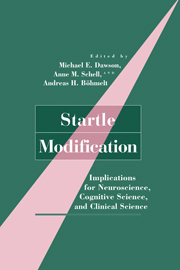Book contents
- Frontmatter
- Contents
- Contributors
- Preface
- Prologue: A Historical Note on the “Discovery” of Startle Modification
- 1 Startle Modification: Introduction and Overview
- PART I BASIC PARADIGMS, METHODS, AND PHENOMENA
- PART II PHYSIOLOGICAL MEDIATION OF STARTLE MODIFICATION
- PART III PSYCHOLOGICAL MEDIATION OF STARTLE MODIFICATION
- PART IV INDIVIDUAL DIFFERENCES AND STARTLE MODIFICATION
- PART V RELATIONSHIPS WITH OTHER PARADIGMS AND MEASURES
- 13 Behavioral Analogies of Short Lead Interval Startle Inhibition
- 14 Event-Related Potential Components and Startle
- 15 Startle Modification during Orienting and Pavlovian Conditioning
- References
- Author Index
- Subject Index
13 - Behavioral Analogies of Short Lead Interval Startle Inhibition
Published online by Cambridge University Press: 26 March 2010
- Frontmatter
- Contents
- Contributors
- Preface
- Prologue: A Historical Note on the “Discovery” of Startle Modification
- 1 Startle Modification: Introduction and Overview
- PART I BASIC PARADIGMS, METHODS, AND PHENOMENA
- PART II PHYSIOLOGICAL MEDIATION OF STARTLE MODIFICATION
- PART III PSYCHOLOGICAL MEDIATION OF STARTLE MODIFICATION
- PART IV INDIVIDUAL DIFFERENCES AND STARTLE MODIFICATION
- PART V RELATIONSHIPS WITH OTHER PARADIGMS AND MEASURES
- 13 Behavioral Analogies of Short Lead Interval Startle Inhibition
- 14 Event-Related Potential Components and Startle
- 15 Startle Modification during Orienting and Pavlovian Conditioning
- References
- Author Index
- Subject Index
Summary
ABSTRACT
Short lead interval startle inhibition is widely viewed as reflecting a low-level inhibitory/sensorimotor gating mechanism that serves to protect the processing of a lead stimulus from the potentially disruptive impact of a startleeliciting stimulus. However, despite the acceptance of this view, it has received little empirical attention, and hence the significance of startle inhibition for cognition is not well understood. This chapter explores the cognitive significance of startle inhibition by comparing it with five behavioral cognitive/clinical measures that have an “inhibition-based” theoretical interpretation: attentional blink, negative priming, backward masking, perseverative responding on the Wisconsin Card Sorting Test, and thought disorder as reflected by the Ego Impairment Index. In each case, we explore the possibility that the behavioral and startle measures reflect a common underlying inhibitory process, comparing each measure to startle inhibition in terms of similarities and differences relating to experimental procedures, time course, critical stimulus characteristics, and patterns of response in normal and pathological subject groups.
Introduction
One reason for psychology's increasing interest in startle modification measures is their hypothesized reflection of cognitive processing, particularly in the case of the short lead interval measures. As reviewed earlier in this book (Chapters 3, 7, and 11), the dominant theoretical interpretations of short lead interval startle inhibition are (1) that it reflects a low-level inhibitory mechanism protective of lead stimulus processing (e.g., Graham, 1975, 1980) and (2) that it also reflects a more general inhibitory process, termed sensorimotor gating, a critical component of intact cognitive processing that involves the ability to filter or screen out irrelevant sensory, motor, or cognitive information in the early stages of information processing (e.g., Braff & Geyer, 1990; Geyer, Swerdlow, Mansbach, & Braff, 1990; Cadenhead, Geyer, & Braff, 1993).
- Type
- Chapter
- Information
- Startle ModificationImplications for Neuroscience, Cognitive Science, and Clinical Science, pp. 269 - 283Publisher: Cambridge University PressPrint publication year: 1999
- 4
- Cited by



